Enroute to the first posting: Inukjuak
Summer of 1982. Today is the departure from Montreal towards Inukjuak. Nordair’s Boeing B737 takes off and immediately heads northward. It will fly along James Bay and, upon reaching Hudson Bay, will land in Kuujjuarapik, its final destination. From there, an Austin Airways’s Twin Otter will take us over to Inukjuak , an isolated posting further to the north on the east coast of Hudson Bay.
A Boeing B737 landing on the Kuujjuarapik 5000 feet gravel runway uses special procedures. This is a short runway for a loaded aircraft, and braking is less effective than on asphalt. There is no significant margin for error. The wheels must touch as close as possible to the runway threshold, followed by maximum breaking. Passengers really feel the deceleration. The same calculation applies for takeoff: the pilot positions the aircraft close to the runway threshold then applies both the brakes and maximum thrust, and once the appropriate parameters are reached , releases the brakes. As usual, weight and balance, density of the air, airport altitude as well as direction and strength of the winds are all precisely calculated for the aircraft to be airborne before the end of the runway.
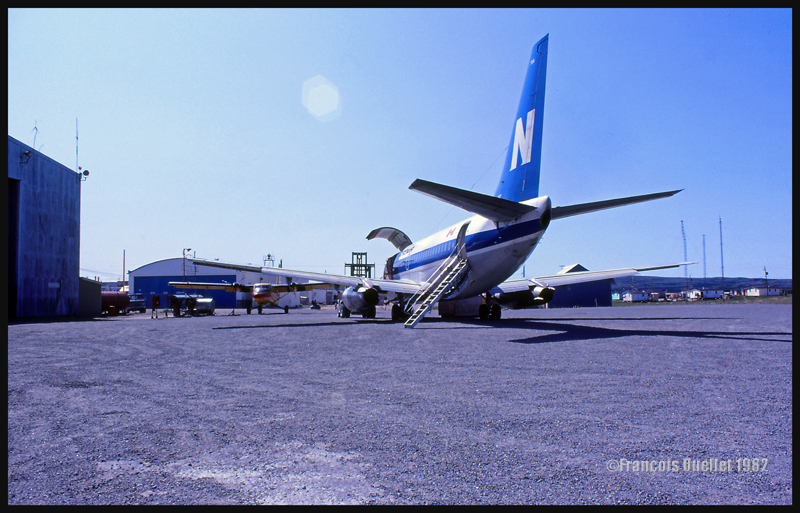
After a short stopover, the Twin Otter is now ready for the trip to Inukjuak. The takeoff from Kuujjuarapik goes without problems. I am sitting in the first class section, behind some cargo held by a net. For champagne, I will have to wait for the boxes to be removed from the hallway.
Then a slow descent is started to Inukjuak. From my window, I can see a small group of narwhals. I feel like I’m dreaming but, after a quick research in scientific documents, learn that narwhals can be found in small groups mainly in the north of Hudson Bay.
The aircraft is now getting closer to Inukjuak. The flaps are extended and it is possible to see the runway before the plane turns on final. It is two thousand feet long and made only of sand thick enough to render its surface unstable.
Upon arrival, someone comes my way with a motorcycle. He offers me a ride to the staff-house, even if there is only a fifteen or twenty seconds walk. I politely declined the offer, but the personage insists. Not wanting to give a bad impression just as I arrive, I finally accept and try to find a small place on the seat of his tiny motorcycle. Hardly have we started to move into the soft sand that the driver loses control of the vehicle. We fall (what a surprise!), but there is no serious consequence. Welcome to Inukjuak!
When in doubt, action is worth more than inaction
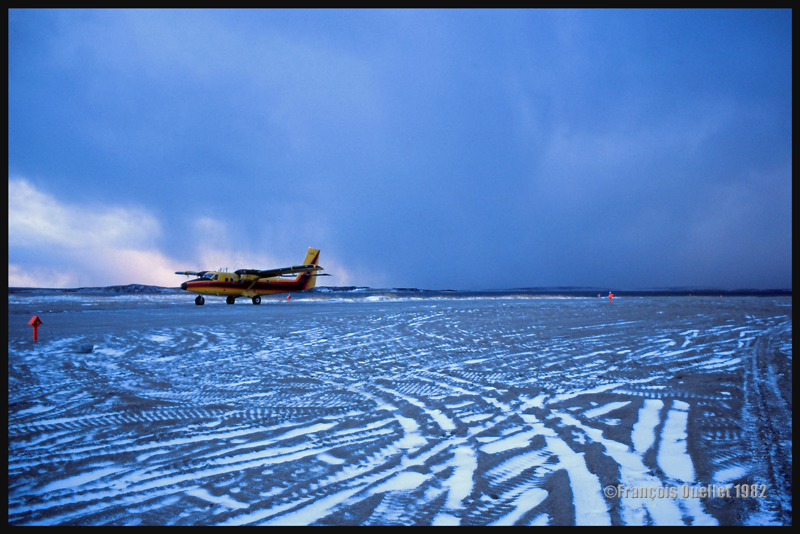
During my first working days at the Inukjuak flight service station, in 1982, I received a call from a Twin Beech 200. The pilot of this aircraft registered in the United States indicated that he wished to land at Inukjuak for a short stopover. Several passengers were on board. I gave him the necessary information and followed its progress towards the airport, through subsequent radio communications.
It is assumed that a pilot wanting to land at an airport has prepared himself and knows the length and orientation of the runway, as well as its constitution (cement, asphalt, gravel, grass, sand). These are absolutely essential information, like ensuring that there is enough fuel on board the aircraft. This makes the difference between an accident and a successful landing. I doubted that Inukjuak, with its soft sand runway, was suited for an aircraft like the Beech 200.
Being a pilot myself, I was uncomfortable to ask him if he was aware of the characteristics of the Inukjuak runway, because this was such basic information. Moreover, having no experience as a flight information specialist yet, I considered unimaginable that in the early days of a new career, I had to deal with a pilot that was not adequately prepared, and would soon put his life and the lives of his passengers in danger.
I kept on thinking that if the pilot was responsible for this type of aircraft, he must have had hundreds, if not thousands of hours of flying experience. It would be like saying: “Don’t you think that the plane is too big for your abilities?”
The aircraft was now on final for the runway, a few miles away. I decided to ask the fateful question: “Are you aware that you are about to land on a 2000 feet soft sand runway?” I was anticipating his reply, but the pilot softly said: “OK, we’ll do a missed approach and will head somewhere else. Is Kuujjuarapik acceptable for us? “I answered positively and in the following seconds, the airplane overshot the runway and headed southward for the next airport.
From that day and the following decades, I vowed to never take anything for granted. When in doubt, action is worth more than inaction…
A visit at the Inukjuak flight service station (1982)
In 1982, while I work at Inukjuak FSS, we offer advisory service to arriving and departing aircrafts. We also act as a means of communication and relay for ships as well as for airplanes, through VHF and HF frequencies. I only remember regular call-signs like Air France 004, who always used to call in the middle of the night, and KLM692. We also have radio contacts with military aircrafts.
Knowledge of Morse code is mandatory, although reserved for occasional use only. Weather briefings to pilots are scarce. The technology available at the time is very basic. All the data received, every minute of the day, is printed automatically. Miles of paper must be managed by the staff on a monthly basis.
Working seven days a week in an isolated post, sometimes during twelve or sixteen hour shifts quickly becomes repetitive. In order to see something else than the flight service station, one should not miss the opportunity to participate in activities with the local population whenever possible. So one day I decide to prepare an elementary weather course in order to present it to Inukjuak children.
I then contact the Inukjuak policeman who is also responsible for the Scouts. I explain my idea and propose that a moment be found where we could all meet. I would offer a weather presentation followed by a question and answer period. Posters are prepared with topics specifically chosen to encourage participation by the kids. On the given day, about ten Scouts show up with the chief. Sitting along a wall on the gym floor, we spend a good two hours discussing about weather and aviation.
I also had the opportunity to receive a few visitors in the flight service station, accompanied by their teacher. Other times, while taking a walk, it was possible to witness a shinny hockey game. For the picture below, two bystanders accepted to pose with the hockey players.
Illegal fishing on the Innuksuak river
In the early “80s, while I was working at Inukjuak FSS, a floatplane entered our control zone without communicating with us. He was flying at low altitude over the area with the obvious intent to do a stopover on the Innuksuak River, a few kilometers inland. We tried to contact the pilot but he never replied. We started to suspect that illegal fishing was the reason for his trip in northern Quebec. The aircraft owner had possibly not paid the mandatory fishing fees to get access to Quebec controlled territories.
Thanks to the cooperation of the villagers, we managed to get the registration of the aircraft. A quick search allowed us to determine that it was owned by a company operating from a base in northern Ontario.
We expected that the aircraft would be airborne in few hours, loaded with fish. And it was obvious that the pilot would not take the risk of refueling at our airport. He would therefore be forced to land in Kuujjuarapik (CYGW) for fuel.
We contacted Kuujjuarapik FSS specialists and asked them to note what would be the final destination of the aircraft. It was an airport in the north of the Abitibi region, under Rouyn-Noranda FSS responsability. The staff of many flight service stations worked together to follow the aircraft to its destination. Police officers drove to the airport and waited for the aircraft to land. I imagine that the seizures and fines were important.
In this story, the initiative and collaboration of Inukjuak inhabitants were essential. Without them, it would have been impossible to get the registration of the aircraft.
The manager who lost his appetite

A Transport Canada manager had to occasionally leave the comfort of his office in Montreal to visit one of the flight service stations located in northern Quebec. So in 1982 he made the journey to Inukjuak, using Nordair for the leg between Montreal and Kuujjuarapik (CYGW).
From there, an Austin Airways Twin Otter brought him to Inukjuak. But few minutes after the aircraft was airborne from Kuujjuarapik, the cloud base dropped dramatically and the pilot later told us that he made the trip with no more than 200 feet of clearance between the Hudson Bay water and the clouds.
The plane arrived in Inukjuak during the afternoon. At dinner, the chef offered a hot meal, but the manager refused to eat anything, stating that he had absolutely no appetite. He later told us that to see the surface of the water so close to the plane and feel the mechanical turbulence throughout the trip had cut his appetite. We realized that our manager was not very comfortable with “non standard” flights.
On the return flight, he was the sole passenger on board, the remaining space being occupied by cargo. We knew the pilots very well and asked them a small favor, which was a takeoff with a tight turn to the right. This was done skillfully and certainly created a surprise with the traveler.
On the flight back to Montreal, while on a stopover in La Grande (CYGL) he sent us a message via teletype that spoke volumes about his appreciation of the turn. I must say, in all honesty, that the pilot had given more than the client requested, and that the traveler had the chance to experience a 70 degrees right turn. It was enough to keep him from traveling up north for a while.
The long awaited aircraft
During the years the Inukjuak flight service station was in operation, there was something an Austin Airways pilot could count on: on the arrival of the aircraft, there would often be somebody from the village waiting to give a hand in unloading the cargo or provide some kind of services to shorten the stopover time. The villagers were indeed regularly calling Inukjuak FSS to know if there was any aircraft inbound, and if it was the case, what was the estimated time of arrival. We were used to questions like “What time plane?”, “Is that food plane?”, “Is that mail plane?”.
Upon landing, we could see, arriving from the village, a fuel truck and other pick-ups and Honda three wheelers. The postmaster came to fetch the mail, the villagers to meet passengers and family members, and the businessmen to unload their cargo or fuel the aircraft.
There was a similar interest regarding the arrival of the first vessels of the season, in late summer. Besides the occasional icebreaker presence, we witnessed the arrival of the Shell tanker, responsible to supply the villages along the coast. Barges loaded with heavy machinery and crated material were finally reaching northern villages after more than a week of navigation, taking advantage of the low tide to deliver their cargo. Some of those vessels were damaged by ice and sometimes had to be repaired on the spot before they could resume their journey.
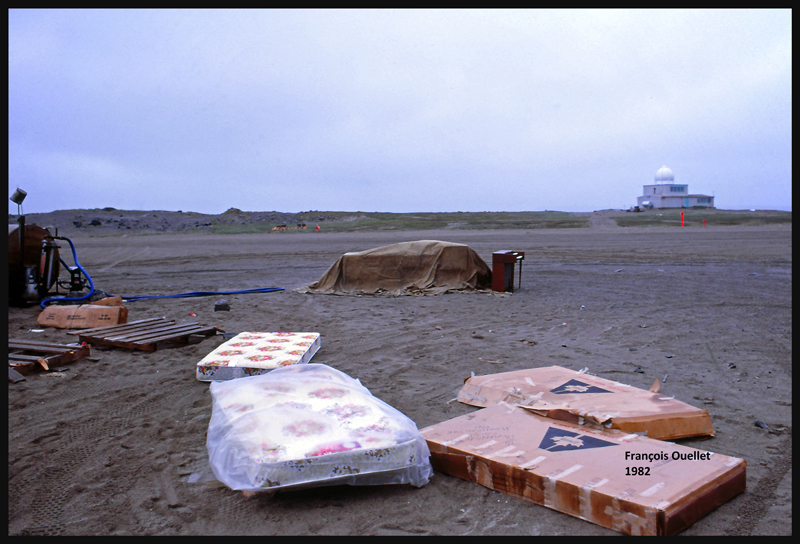
One day, an anti-submarine patrol aircraft CP140 Aurora having completed his work over Hudson Bay contacted us to receive some information. Since the operations seemed momentarily completed and the aircraft was now moving to another area, the pilot was asked to do a “low pass” above Inukjuak FSS. The pilot agreed and soon enough, the plane was zooming above our facilities disappearing moments later in the clouds. I still remember the flood of phone calls that the aircraft fly-by created. Unable to see the Aurora, now above the clouds, the villagers were now asking: “Is that food plane? “,”Is that mail plane ? “.
A low pass is sometimes requested to get a close-up of an aircraft and to allow the staff to hear the roaring engines as the aircraft zooms by the building. This also creates an opportunity to take a picture. Every pilot that I have known throughout the years would gladly accept this opportunity to add some action in his routine…
The Inuit who wanted to shoot Whites with a .303 caliber rifle
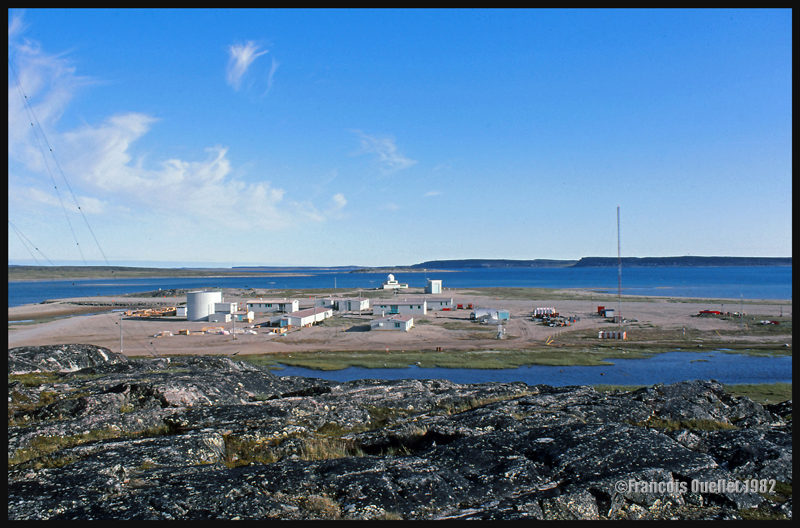
Note: It is only an out of the ordinary true life story. Normal relations between Whites and Inuits are entirely peaceful. Besides, we all know of situations in the southern cities where whites have tried to shoot people. The following story therefore presents an unusual and rare case.
In Inukjuak, in 1982-1983, the buildings layout was simple. On top of a nearby hill was the whole village, populated overwhelmingly by Inuit. Down the hill, near the airstrip and Hudson Bay, were the few buildings where Environment Canada and Transport Canada employees could be found. There were only Whites living and working in this area.
One evening during winter` 82 -` 83, someone knocked on the door and entered immediately without waiting for an answer. It was the auxiliary police officer. He was an unarmed young man who occasionally helped the unique village policeman. He told us that the policeman was absent from the village and that he must fend for himself. He urged us: “Lock your doors and turn off the lights, do not go out unless it is essential, as there is one Inuit armed with .303 caliber rifle who wants to shoot white people.”
It was, of course, a complete surprise for everyone. It was easy to deduce that the shooter looking for whites would choose the easiest solution and head towards our buildings to shoot somebody at random. Not wanting to be a sitting duck, I went to my room and grabbed a locked suitcase that had been sleeping for months on a shelf. I took out a Remington Classic 700 BDL Bolt Action and loaded the magazine. We established a plan, with the other two persons in the house. Two of us would have to get out and head toward the flight service station, where there was an unarmed FSS female employee working alone. Chances were that she was not aware of what was going on. One of us would bring her back home and the other one would then complete her night shift at her place, since the station could not be left unattended.
While we would be gone, there would be one person left in the house with a gun to protect himself if necessary. This employee had just arrived in Inukjuak. I still remember his reaction when we were getting ready to leave. I can hear him say: “But what is this crazy place?”
We closed the outdoor floodlights and headed to the flight service station with our weapons. Walking in the dark, crouched like soldiers during wartime, we arrived at the Transport Canada building where we found the employee occupied at her normal duties, completely ignoring the possible presence of a nearby shooter. I took her place to complete the night shift while she returned home accompanied by an armed employee.
Once alone in the operating room, I shut the lights while keeping a small lamp to illuminate the console radio frequencies. I lay the rifle flat on a counter, the lock removed for faster use if needed. The radio console was located opposite a large window: it left us totally exposed to anyone who would decide to shoot through it. I therefore had to stay away from the normal working position, except when responding to radio calls, until we received fresh news about the shooter.
The improvised night shift ended without incident in the station, but I learned that multiple shots were fired at a vehicle traveling near our facilities. Projectiles pierced doors, but luckily they did not hit the vehicle occupants. Within hours of the event, a tactical response team of the Sûreté du Québec arrived in Inukjuak and controlled the shooter.
Even if this story took place decades ago, I still remember very well the atmosphere on that evening. When untrained civilians must load firearms to potentially use them against another human, it cannot be forgotten.
Emergency clean-up
In a Quebec northern Inuit village, in the early ` 80s, there was still a fair amount of homes that were not equipped with toilets as we know them today. The occupants of these properties had to relieve themselves by sitting on a bucket covered with a garbage bag that people called “Honey Bag “. Fortunately for Environment Canada and Transport Canada staff working in Inukjuak, sanitary facilities were exactly like what could be found in southern cities and it was not necessary to use makeshift means.
The fact remains that a White male was hired as director of a local public institution and lived with his family in a house equipped with this type of “Honey Bag ” facility. On a beautiful Saturday, he and his wife were receiving guests for dinner and they were taking care of the final details. The wife had asked her husband, few days earlier, to take the “Honey Bag” out of the house and put a new bag on the toilet.
The man had neglected his task and the bag had gained volume and weight. But it was now Saturday, so he could no longer procrastinate. He grabbed the bag, closed it and crossed the living room heading toward the door. At the moment he found himself in the middle of the room, the bag broke and all of its content spread on the carpet.
It was reported to us that there was an emergency clean-up throughout the afternoon to try to correct the situation. There was no way of knowing if the guests were able to enjoy the subtle aromas of the good wine served with the dinner…
Inukjuak: last hope for a Twin Otter low on fuel
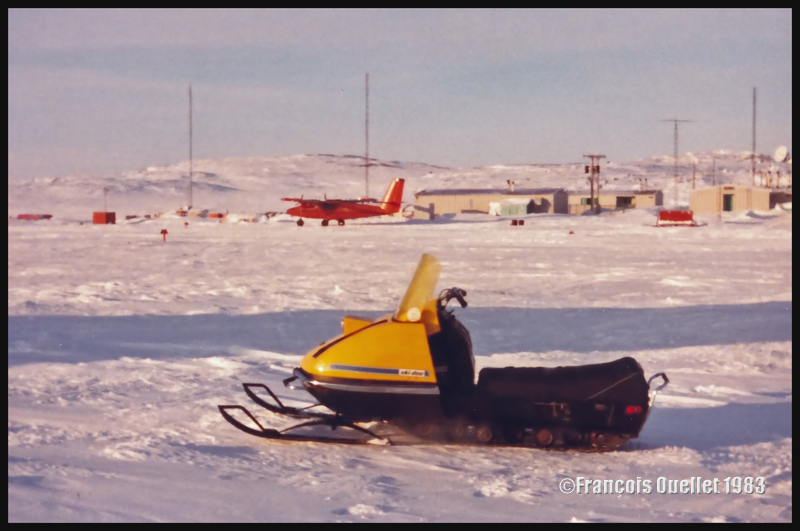
One winter evening, in 1983, Inukjuak FSS received a radio call from a Bell Canada Twin Otter that was in trouble. The fog had invaded the Hudson Bay coast in several places, and landing at the planned alternate airports was now impossible. Weather conditions still being acceptable in Inukjuak, our airport became the last option for the pilot. Unfortunately, our runway lights were out of service and a solution had to be found quickly.
Phone calls were made. Several Inuit arrived in snowmobile and installed their machine on each side of the runway, in more or less regular intervals, so as to light the outside limits of the landing surface. The pilot made a normal approach and the aircraft landed without problem. This kind of service provided by the Inuit was not something new. The pilots were always happy to be able to rely on this emergency auxiliary lighting supplied by the inhabitants of northern villages when there was a sudden problem.
Allegations about the massacre of sled dogs during the fifties and sixties
When I was working in Inukjuak in 1982-1983, I liked walking along the Hudson Bay coast. One day, I got for company a big Canadian eskimo dog belonging to an Environment Canada employee. The dog had found a way to free itself from its leash and I took advantage of his company to explore the coast.
It was not and still isn’t frequent to witness unattended dogs on a territory inhabited by Inuits. During summer, the latter normally carry the dogs on nearby isolated islands along the Hudson Bay and Ungava coasts. Naturally, the Inuits come back at regular intervals to feed them. This was still going on in 2013 as it serves multiple useful purposes. According to an Inukjuak Inuit with whom I was discussing recently, the island allows the dogs some freedom of movement since they don’t need to be tied all day long to a short rope. Also, the dogs are more comfortable on the islands since there is far less mosquitoes.
In 1982, I heard rumors according to the fact that dogs left free might be brought down, but I did not witness such a thing. Local policy was such that stray dogs would not be tolerated because they presented a threat for the population. Of all that has been said concerning dogs that were brought down for the most diverse reasons, the recurrent story is the allegation of massacres of Eskimo dogs during the fifties and sixties. The documentation found in this respect states that about one thousand dogs were brought down during those two decades, most pointlessly, in the various villages along Hudson Bay, Ungava Bay and Davis Strait.
An interim report about the investigation on this subject was handed in 2009 to the Makivik Corporation and to the Government of Quebec by the retired judge Jean-Jacques Croteau from the Quebec Superior Court. We learn of this report that the RCMP as much as Surety of Quebec police forces had participated in the elimination of sled dogs during those years, by interpreting in a personal and fairly restrictive way a law dating from 1941 and dealing with “The Agricultural Abuses Act”. When it was created, this text of law aimed at creating a system of non-responsibility for a person who would shoot down a stray dog according to specific conditions stipulated in the text of law. Reference was made here to actions taken against stray dogs attacking sheeps and farm animals.
The police quickly made excessive use of this section of the law to apply it on a territory which was not targeted by the law. I can make a mistake, but I believe that nobody ever observed an Inuit sheep farmer on a farm in the Arctic. The most important events occurred after the RCMP gave back the responsibility of the territory to the Surety of Quebec. That police force showed a complete misunderstanding of the Inuit culture. According to the proofs presented in the report, policemen arrived in a village without warning and killed stray dogs, chasing them even under houses, without having taken care of verifying if the dog was sick or dangerous. We find in the report the testimony of two Kangiqsujuaq Inuits asserting having seen two policemen arriving by seaplane, and without saying a word to whoever it is, begin to chase stray dogs through the village. Thirty two animals were eliminated and the policemen left the village without giving explanations.
The report states that the Northern Quebec Inuits were never consulted as to the impact of the law on “The Agricultural Abuses Act”, a totally inappropriate law for them, not taking into account their ancestral rights. The Inuits depended completely on dogs for transportation, to go hunting and fishing. We can read the following passage, in the last sections of the report: “after 1960, the actions and the behavior of the police force went too far. Nothing was to be understood. The officers demonstrated a total lack of consciousness with regard to the fundamental rights of the Inuits, their culture and the importance of dogs for their subsistence. The behavior of the officers, which could not be ignored by the provincial and federal civil administrations, had a damaging effect on seventy-five dog owners and their family, compromising their capacity to meet their needs in food “. No help was offered by the authorities to compensate for the loss of dogs.
The judge finally noted that he had no other choice than to declare that Canada and Quebec did not respect their fiduciary obligations towards the Inuits. I imagine that monetary compensations have since been offered, unless this report was only the first step in the process aimed at establishing the responsibilities and some future compensation.
The UFO invented in 1983 in Inukjuak
A most improbable UFO was created in Inukjuak around 1983. According to its duties, the Environment Canada staff at work in the upper air station had to launch, twice a day, a free-rising balloon which could go up to approximately 70,000 feet. These hydrogen filled balloons were pulling a radiosonde which was transmitting data such as wind speed and temperature at all altitudes.
One day, an observer attached a small battery on the probe as well as five battery fed bulbs. The balloon rate of ascent was corrected to take into account the additional weight of the new equipment. Finally, at darkness, the whole installation was launched. The only thing an observer on the ground could see in the sky was five lights moving quickly together while maintaining the same spacing. The speed and height of the unknown formation were impossible to determine since there was no ground reference.
Observed from the ground, this UFO could be either at 100 feet or at a very high altitude. The object was totally silent and seemed to be moving like nobody’s business. A UFO is now identified, decades later.
A kitchen used as a navigation aid to aviation
The winter 1982-1983 was fierce in Inukjuak. There was a period when the winds were strong enough and the visibility reduced to the point that a rope had to be attached between the staff house and the flight service station (Inukjuak FSS). We held the rope to guide ourselves from one building to the other. And good luck to the employee who would try to carry his meal on a tray between both buildings. A hand held the rope while the other one took care of the tray which was going in all directions. On one occasion, tray and food found their way in the snowbank.
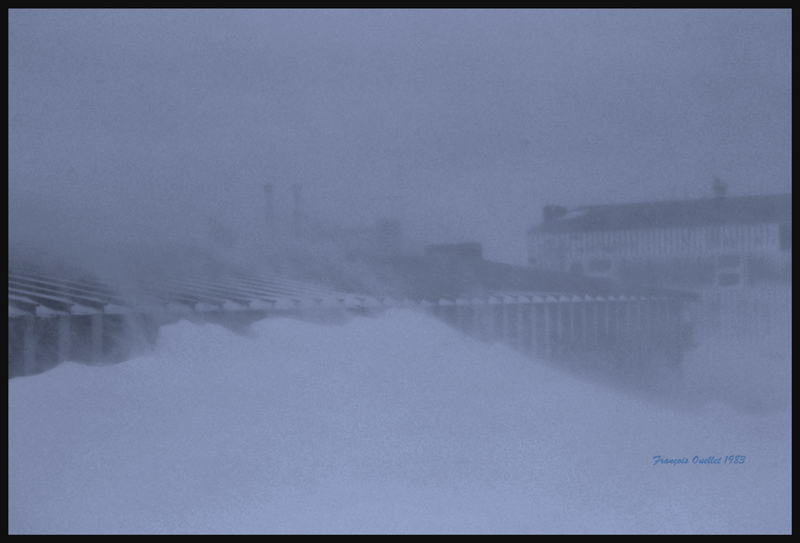
After a storm which seemed endless, I remember that the employees had to dig steps in the hardened snow in order to reach the flight service station door.
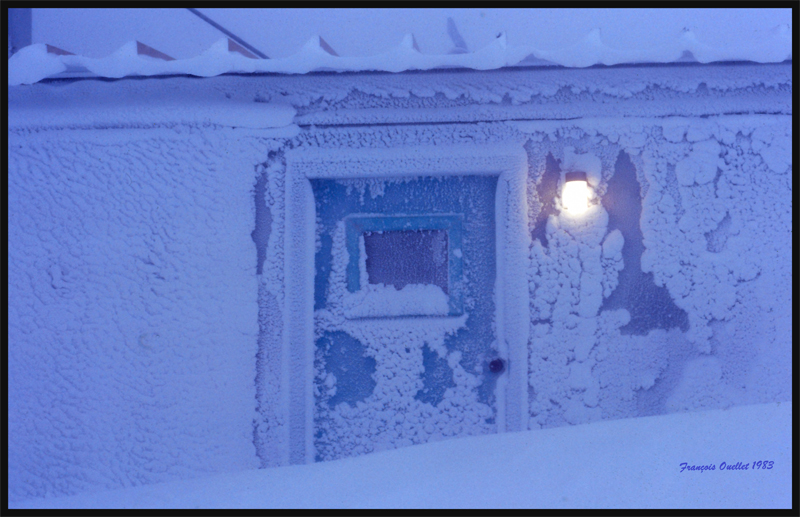
This blizzard, which lasted twelve days, had prevented any take-off and landing. There was no more milk for sale in the village, as it was now reserved for children. Hardly one hundred feet over us, there was a perfectly blue sky, according to the pilots who had tried to land on multiple occasions. But one morning, an Austin Airways pilot decided to risk an approach.
The pilot could not benefit from any precise navigation aid during his approach, as the airport was only equipped with an NDB. So he trusted his local knowledge and what was left of his judgment. He knew that the staff house was painted green and situated just beside the runway. I guess that he prepared himself to aim for the colored staff house then make a sharp turn at the last minute. He dived into the storm, estimating the wind drift as much as he could.
At that same moment, our cook was working in the staff house’s kitchen. He was facing a huge bay window and was stunned to suddenly see the nose of a Twin Otter appear a few meters away from the window at the same time as a steep turn was being made to avoid the building. Reverse thrust was immediately applied to immobilize the plane as fast as possible. The cook repeated what he witnessed to every employee. I guess that helped him to unwind a bit.
As this was not enough surprise for the day, the plane’s doors opened and, instead of the much needed milk cargo expected by the villagers, we witnessed about ten passengers stepping out the plane and chitchatting like nothing ever happened. This unorthodox approach to the Inukjuak airport would now be one more story added on top of all the others told by pilots offering daily air service to northern villages along Hudson Bay and Ungava Bay coasts.
The cockpit of a KLM Boeing 747 during a night flight over the Atlantic
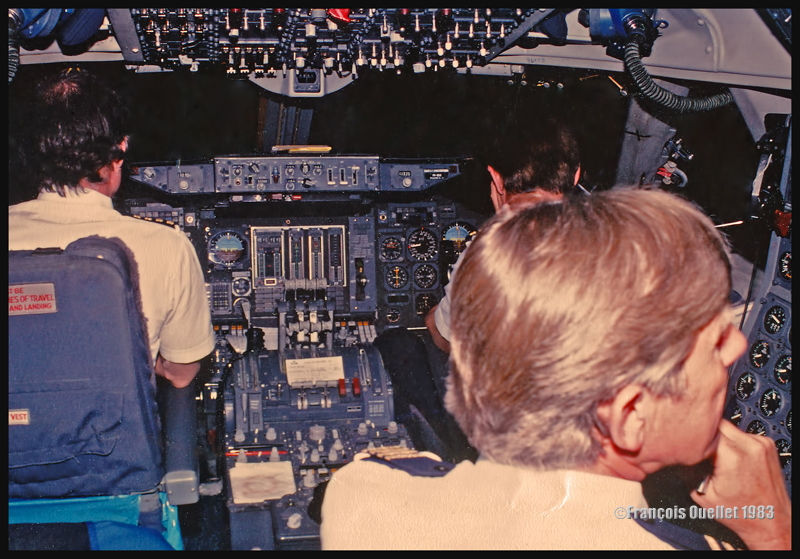
There was a time when it was very simple to visit the cockpit of an aircraft in flight. A request was made to the stewardess, who then coordinated with the captain. Even during this period though, several companies forbade those visits when the plane was over the ocean.
In 1983, during a journey from Montreal towards Holland, I decided to take a chance and ask the on-board staff the dreaded question, hoping to be able to take a picture of the cockpit.
The flight was being made on a KLM Boeing B747. In the middle of the night, while the plane had been at cruising altitude for several hours and most of the passengers were asleep, I discreetly asked the flight attendant for the authorization to visit the cockpit. Naturally, she refused. I tried again, telling her that I was working as a flight service specialist in Inukjuak FSS and that I regularly talked with KLM to provide essential services. To dissipate any doubts, I finally gave her the KLM call-signs that I was dealing with over northern Quebec.
She agreed to deliver my request and, twenty minutes later, I was told: “come with me but pay attention not to wake the first class passengers installed near the spiral staircase which leads to the cockpit “. As I entered the cockpit, the captain turned around, greeted me while he crunched in an apple and returned to his work. Everything was quiet in the cockpit and we could hear a continual light whistling caused by the friction of the air.
After a short discussion with the crew, I asked both pilots and the flight engineer to close their eyes a short moment while I took a photo with flash. A photo impossible to take today, under the same circumstances, due to higher security standards.
And, since I started my annual holidays by visiting a cockpit, I thought it would also be interesting, once in Holland, to visit the famous miniature world of Madurodam, so as not to stay away too long from the aviation world…
Raisins and blueberries in Inukjuak
During the months when there was an on-the-spot cook preparing the meals in Inukjuak, we had it easy because everything was ready when meal time came. It remains that the desserts would have benefited from a little variety. Those were prepared with either grapes or blueberries, week after week, month after month.
We thus had the choice between raisin cakes, raisin pies, raisin puddings, raisin muffins and raisin cookies. When there was no more possibility of ingesting additional raisins, it was now time for blueberries: blueberry cakes, blueberry pies, blueberry puddings and blueberry muffins. However, to add some variety in the menu, there were no blueberry cookies. I was unable to eat raisins and blueberries for a long time following this monthly overdose of the same ingredients.
The cook not being particularly patient, I thought of making him laugh a little by asking him to participate in a trick where the victim would be a new FSS employee who had just arrived in Inukjuak in early afternoon. The latter had not taken any meal yet in the staff house’s kitchen. I knew that the dinner was served at 5 pm and that it was necessary to get organized to be on time. I thus told the cook that I would voluntarily arrive five minutes late with the new employee. That would allow the cook to act as if he was extremely upset. I knew he would be convincing.
Dinner time came. It was 5 PM but training of the new FSS was voluntarily extended five minutes. Then, feigning a surprise, we told him it was necessary to rush towards the staff house, as we feared the cook would be out of his mind. From the corridor that lead to the kitchen, we could hear cauldrons being smashed on the counter while the cook was shouting and complaining that new employees thought they were kings and lacked respect towards the kitchen staff.
The new comer told me that he was not really hungry. Apparently, he was not anxious to face the cook’s anger. The situation got worse when I nevertheless incited him to go in the kitchen and try to arrange things with the cook. Seeing the new guy, the cook doubled his efforts, red with anger. Then suddenly, all the employees in the kitchen burst with laughter and the cook wished a warm welcome to the new FSS, thanking him for having given him a chance to relax a little.
Ice and ships
Several ships naviguate along the Hudson Bay and Ungava Bay during summer. Sometimes, we are allowed to get on board to take few pictures, like it was the case for the two photos above.
When a ship makes a long journey towards the small villages along the Hudson Bay and Ungava bay, it regularly strikes small pieces of ice. The crew has to determine if the boat’s hull will be resistant enough to stay on the desired path.
Unfortunately, it is not always possible to evaluate the situation correctly and the hull sometimes breaks under the impact with the ice. The photo below shows the ship Kanguk, off Inukjuak in autumn 1982, its hull damaged during its journey towards one of the small villages of the coast.
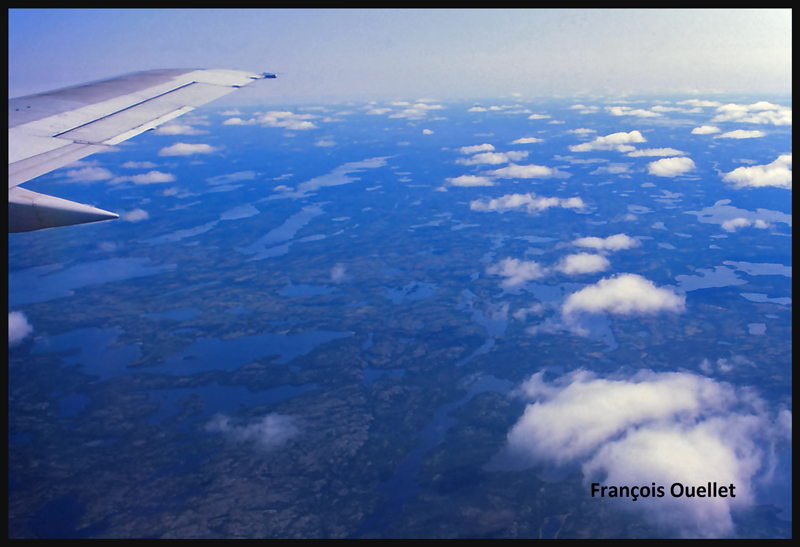

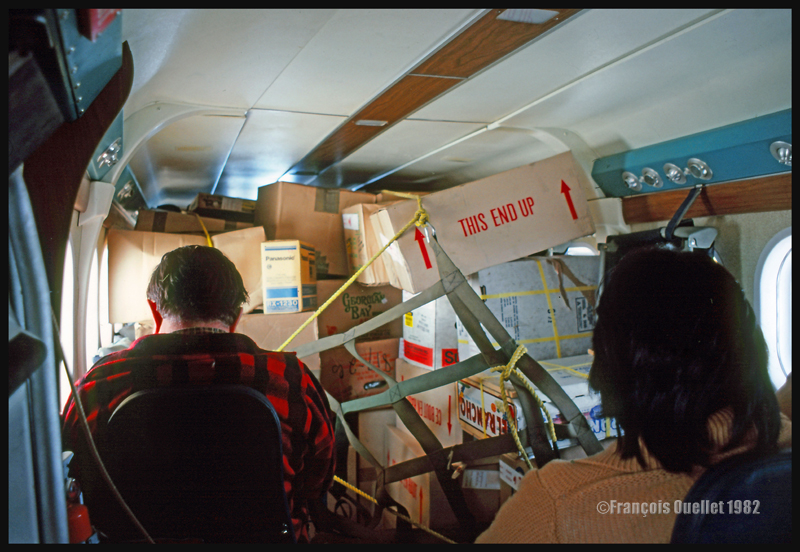
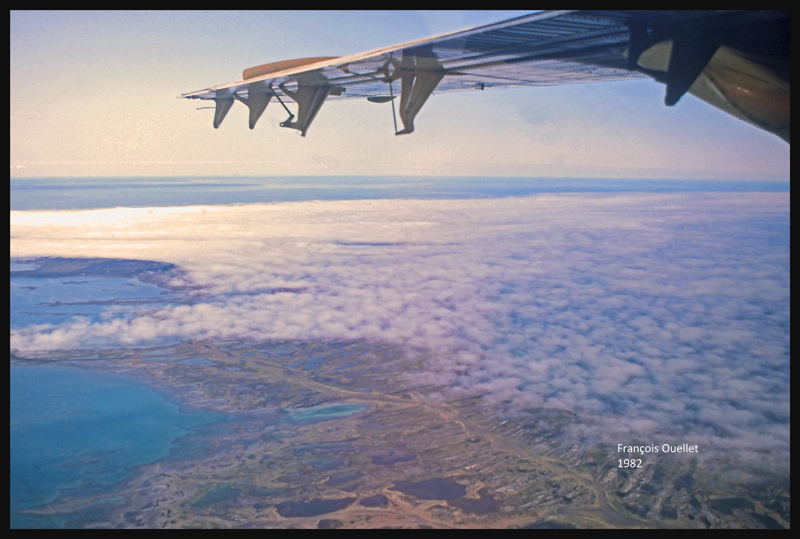

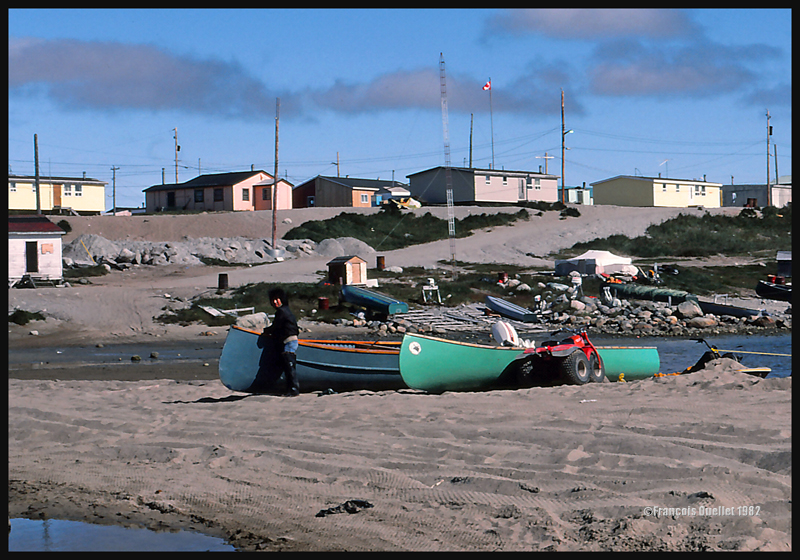
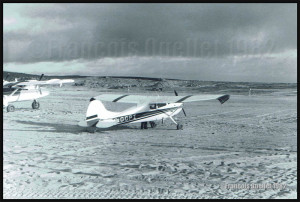
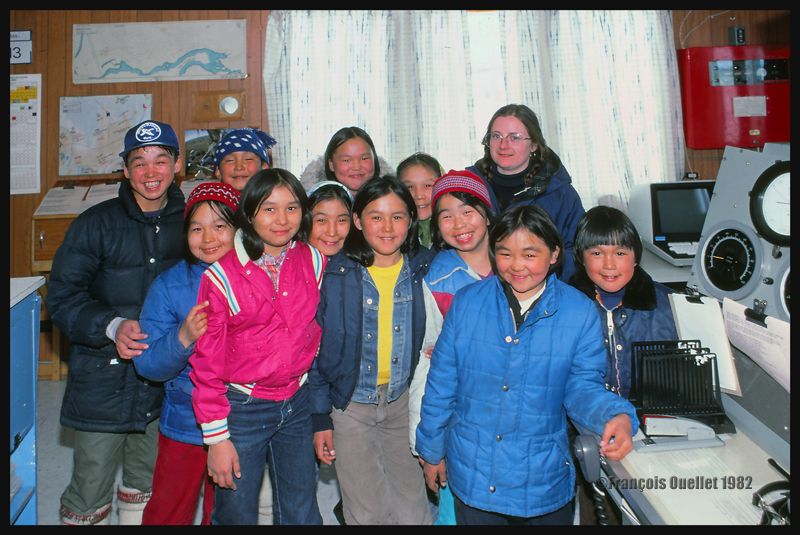
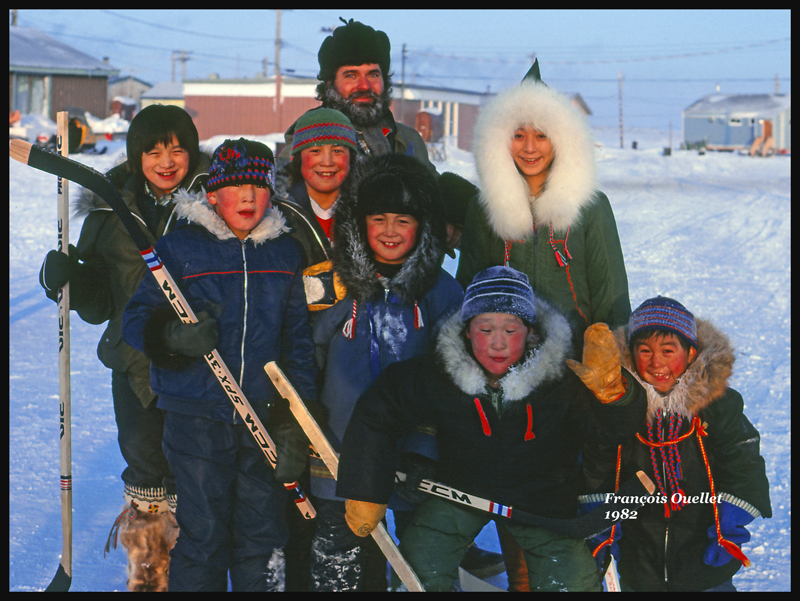
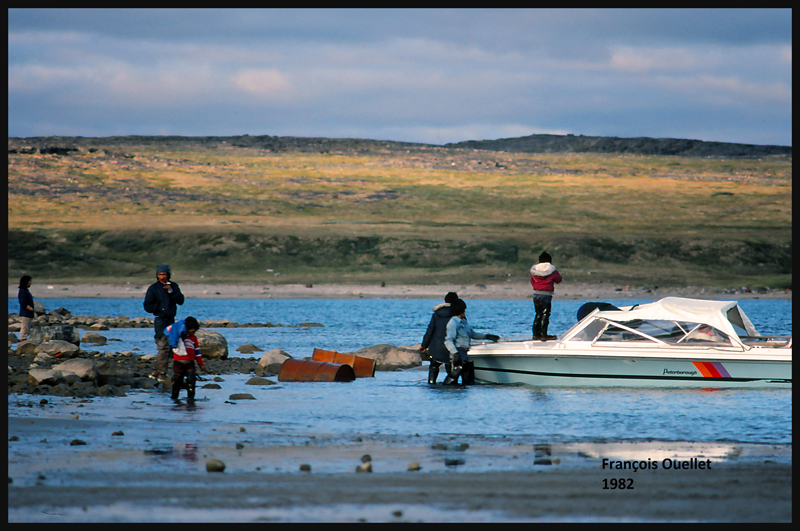
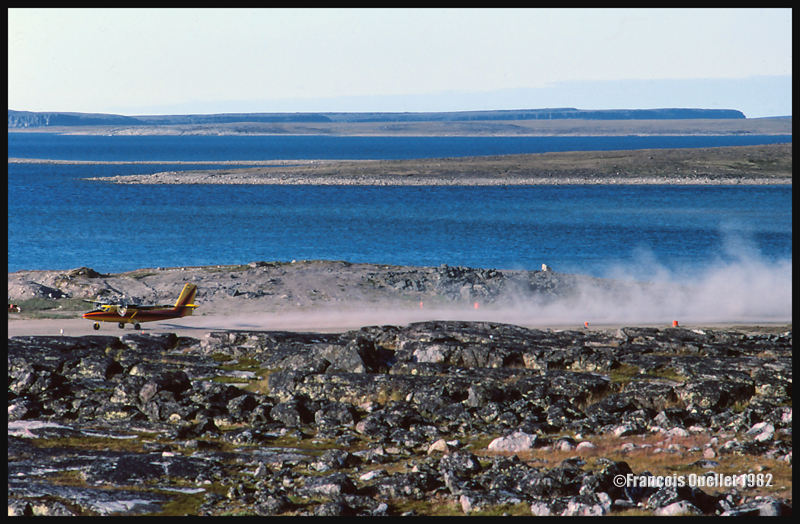
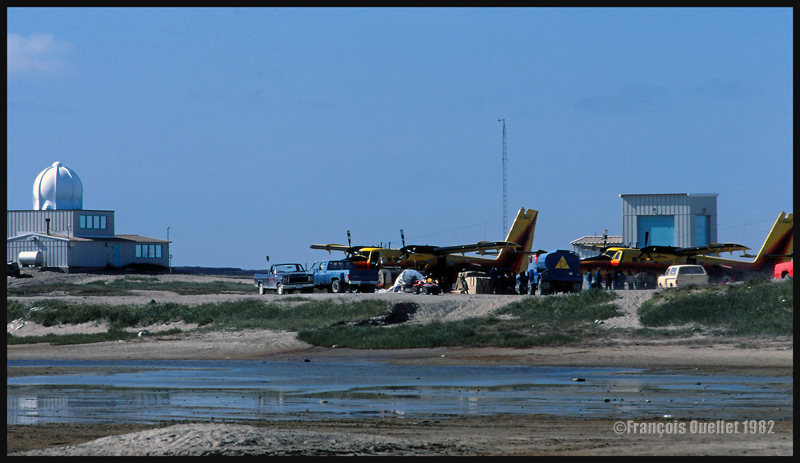
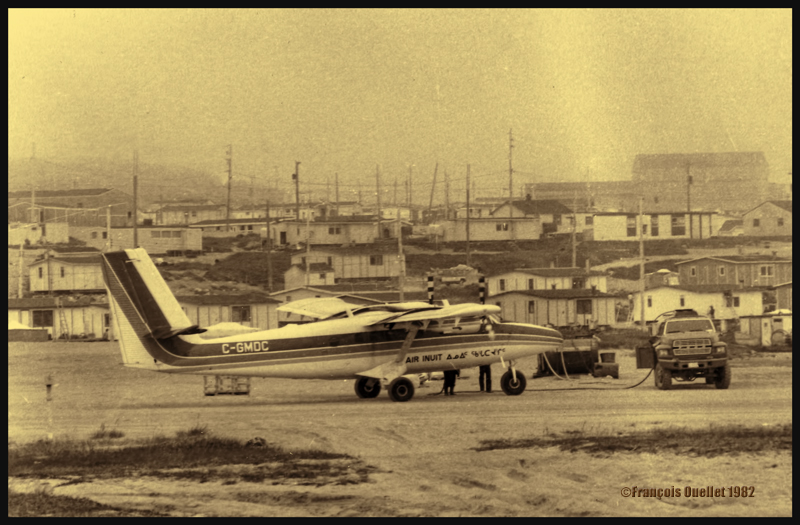
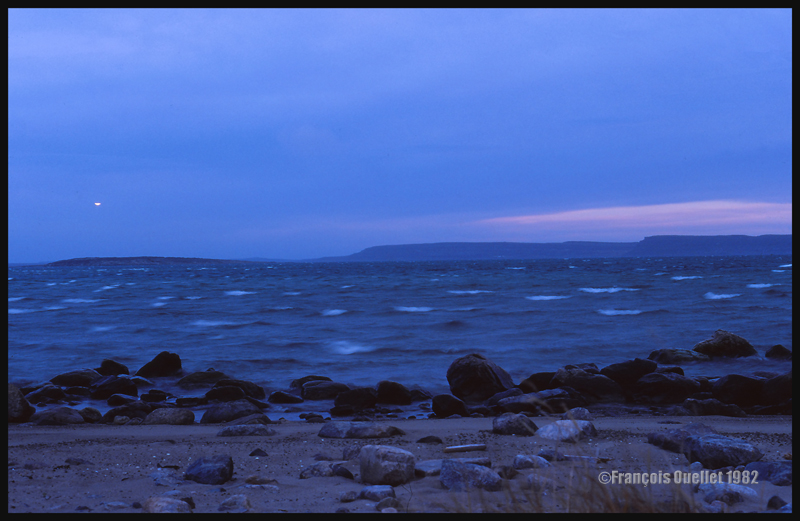
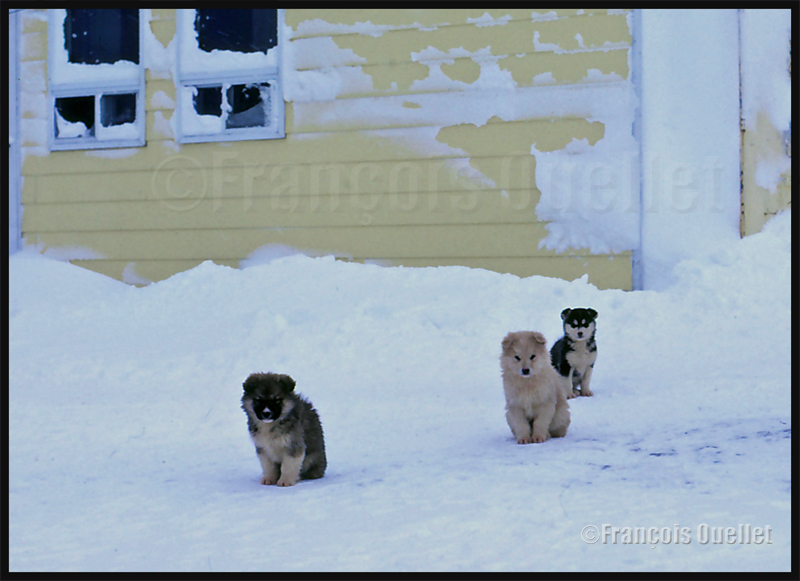
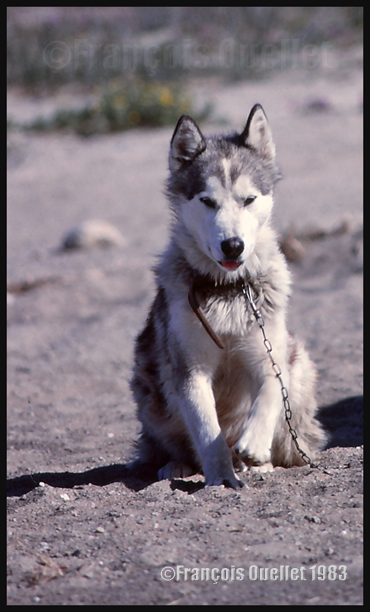
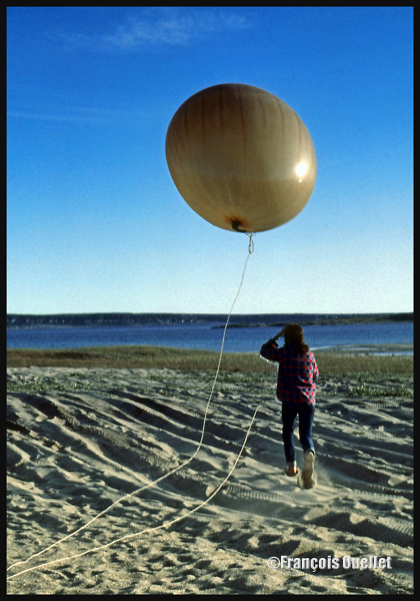
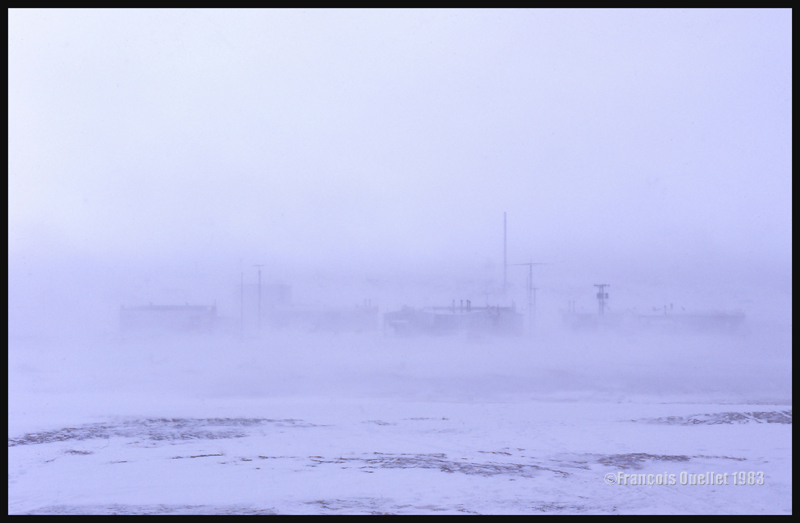
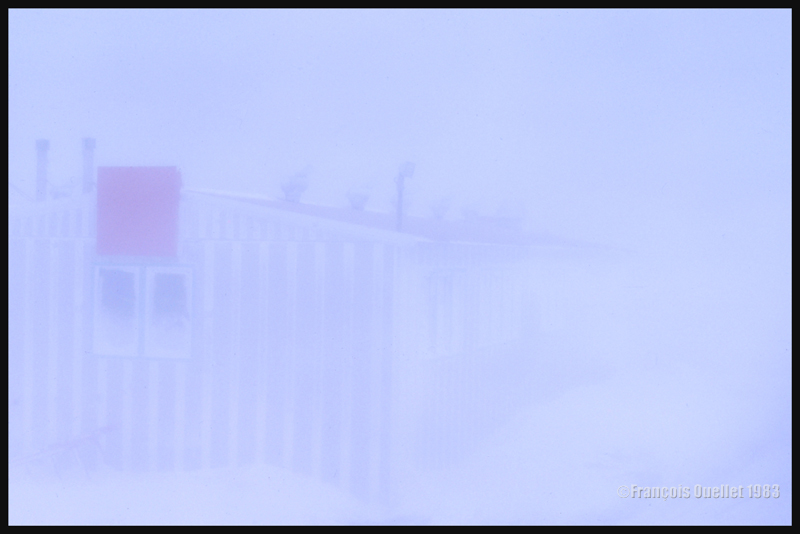
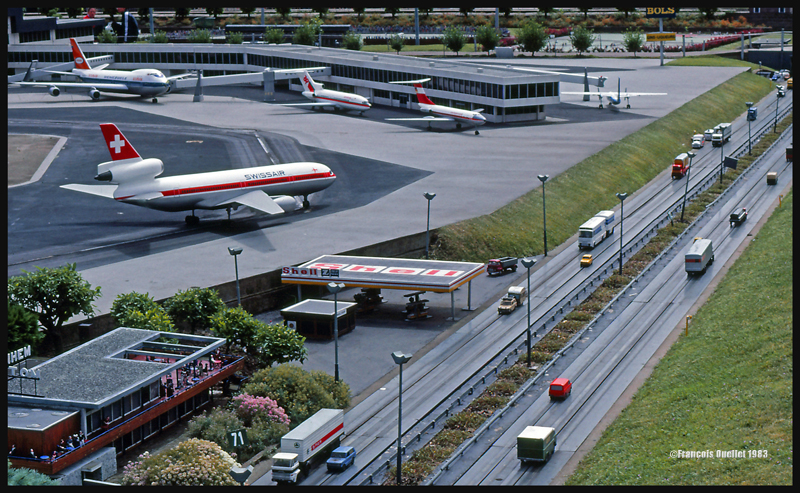
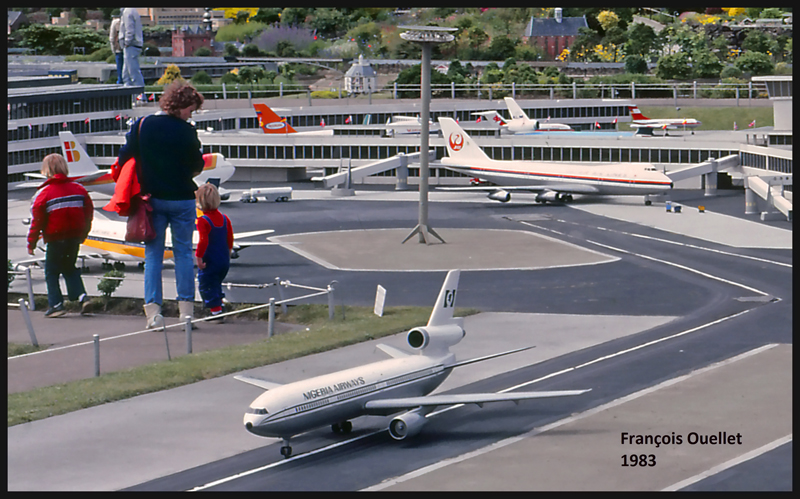


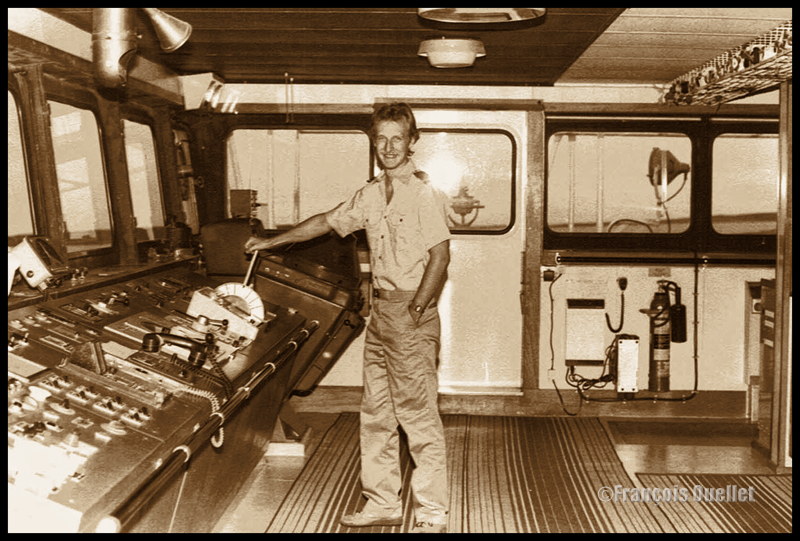
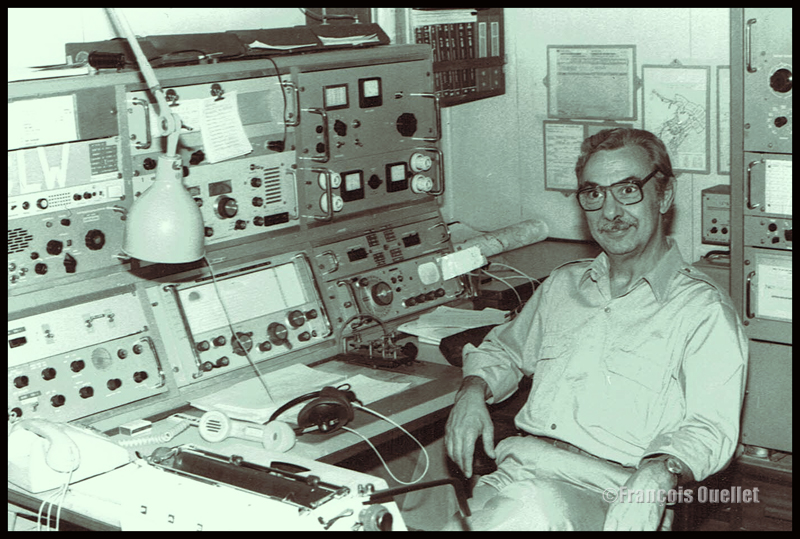
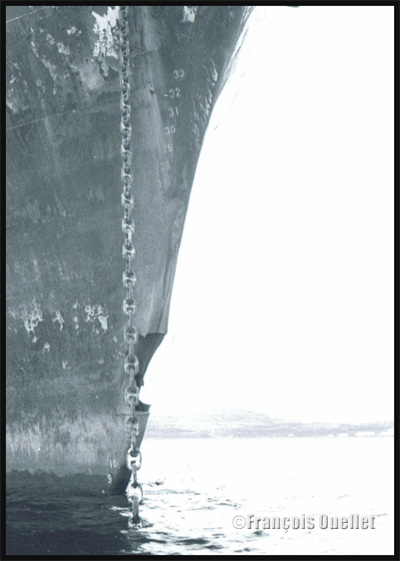
33 replies on “Real life stories as a FSS in Inukjuak”
Story # 2 From Inukjuak
WE had a handy man named Charlie Who had several children. The oldest was Lucy about 12 years she had a friend Sarah and sisters who used to have a lot of fun following us around. They had a nickname for me. I heard them use it a lot and finally asked what it meant in English. They replied ” big boss man” They laughed and I was flattered.
One day I decided to go up river trout fishing, three or four of them tagged along. As I caught fish I knocked them over the head and put them behind me in a cleft in the rocks. I heard a lot of giggling, which wasn’t unusual when they were around. When I went to gather up my catch I noticed all the eyes had been sucked out of the fish. They thought I would be mad because according to them the eyes were the best part. I couldn’t argue with them as I wasn’t about to try one (they were all gone anyway thankfully) Those kids as pesky as they were at times had a way of brightening and day.
I looked up the population stats for the settlement and surrounding camps so I will include that
Settlement 154 Adults and children
Five Mile camp 29 adults and children
Inukpuk’s camp 29 adults and children
Narrows camp 50 adults and children
Abrahams camp 29 adults and children
Sarolie’s camp 63 adults and children
Echalool’s camp 47 adults and children
Total Population 354
Stats compiled 1965 by Dept. of Northern Affairs
Thanks Linden for that very interesting story. Effectively, the kids were always full of life and very curious. I once developed a small weather course for them, as they showed some interest after having visited the flight service station. I wished I had more time to profit of the area to do a little fishing, but when I was there, in 1982-83, we are always short staffed and the regular hours were often 12 and even 16 hour shifts. I remember the spectacular clear green of the Innuksuak River, something I never saw anywhere else.
I can’t believe Armond was still there as a diesel mechanic. May be it was a different Armond. I was in Port Harrison (had to learn to spell inukjuak when it was changed lol) I was there in 66 and 67. Our station was on the other side of the river we had lots of privacy and always had our cannoe at the ready to head to town. There were less than 800 people there at the time. Many things had changed for you guys some for the better some not. One thing better for us was not having to get up during a flight and do an SA then rush back to remember where you were before the recorder record rolled under. I will only tell one story as there are so many.
We had a windy release very windy the instrument on release hooked onto the short wave antenna of our inuit handy man. The kids in the house told me later that the radio was pulled across the room to the window and they thought for a while it was haunted.
I too really enjoyed my time there but then it was on to OIC Nitchequon where i had my own boat and where the fishing couldn’t be beat.
Nice to hear your stories guys.
It is great to hear from you, especially that you were there such a long time ago. I am glad that you told the story about the “haunted” radio, as I am sure no one else in Canada would have remember that and take the time to record it in writing. Feel free to write other stories that you remember, as it is free to write here and it will be officially recorded in the Canadian history of workers in the North, for searchers who may come later on. And by the way, Armand is still the same guy that you and I saw. He spent decades up north.
I was an upper air technician in Inukjuak in the early 90s in the days of the PDP 11 and 9″ floppy disks. I actually worked with Robert Picard in Maniwaki and I send him my best regards. Thanks for the memories.
Hi Mark,
I am glad you stopped by, and happy that you could refresh some memories through the pictures. While your were in Inukjuak, I had been transferred to Iqaluit, where there was also an Environment Canada office located in the yellow cab (Flight service, Environment Canada and the passenger terminal at the time). All those villages along the coast have really changed since we were posted there. I hope that Robert Picard sees your message. Inukjuak was great, the view was superb!
Glad to hear from another former Environment Canada employee!
François
I spent quite a few years in Inukjuak up to 2001. I have great memories of Inukjuak, that’s for sure.
I’d also like to send Mark my best regards.
Thanks.
Robert
Hi Stanley, You got that right. I also like it when it snows down here. The food shops are near empty. Someone has to tell the weather channel guys to stop being alarmists. They scare people for nothing! It’s like they don’t seem to know the criteria for a blizzard.
I spent close to 20 years releasing balloons. A lot of those balloons were released in blizzards or very windy conditions. The balloons were stretched to the limit, so I had to run like heck and toss the radiosonde into the air and pray for a decent take off. Good thing the snow was hard in Inukjuak to run on. I enjoyed it.
I remember doing the SA, RS, and SP reports while doing a flight in progress. So, one eye was on the weather and the other on the graph but more than the usual RS reports went out. Did a lot of running back then! My weather reports were on time but I wouldn’t say the same in the days of the ticker tapes. Those machines were really noisy!
Yes and I’ve heard that with those machines, if you made only one mistake in inputting a message, you had to redo it all over again since it was a piece of paper being punctured at specific places. But I’ve never seen one in action, as I was with the aviation sector.
Hi Stanley, I recall long lasting blizzards. Some were ferocious with winds coming off the Hudson Bay.
One morning I went to work by pickup, (should have gone by snowmobile), to the new weather station near the airport. I didn’t make it because of sudden low visibility, so I left my pickup in a safe enough place and walked the rest of the way to work. The new station was still visible, luckily. That morning , I released a second balloon with difficulty, turned around and couldn’t see the station. I found the Stevenson screen and made it back. I was stuck in the station all day. The weather station was shaking like you would not believe. In the afternoon, I went outside, went about 8 feet, turned around and could not see the front steps. I couldn’t even see my out stretched hands. Real bad!
There was hardly any food at the weather station.
I did the evening release (flight). It was difficult but not as bad.
I walked back home at 22h00 over drifts of 5 to 6 feet on the road to town. I followed the telephone poles and wire.
The next day, my pickup was completely buried in snow. After plowing, two Inuks brought my pickup into the airport garage. The engine was full of snow. I was really grateful.
The snow drifts at the weather station exceeded 10 feet.
Blizzards up in the Arctic are terrible and some are long lasting. Down here in the south (Montreal), the weather channel calls an approaching snow fall a blizzard. I find that funny!
Yes, it is interesting the way the weather channels alert everyone for each moderate snowfall. The habit of calculating the windchill factor every time they talk about the temperature scares the people who are already looking for a good reason to stay inside. Up north though, it can really be life threatening and you learn to watch for yourself. Last week in southern Eastern Canada, they called it the storm of the century. It was snowing, it was windy and it was cold. Well, it was winter. I ended up doing my grocery almost alone at Costco, then drove to another store for the rest of the shopping. The advantage of all those alarms when you live in a big city is that you have the road and the stores to yourself. I can understand though that on secondary roads you have to be more careful because help might take some time to arrive in case you find yourself in a bad situation.
With reference to balloon launching, I understand that it might be quite tough to launch those big weather balloons in very strong wind conditions. Those balloons are huge and you don’t want the transmitter attached to the balloon to hit the ground a few times before the balloon finally start climbing!
As an Environment Canada employee, I am sure you remember all those remarks that had to accompany an hourly weather report that was missing: there were all kinds of remarks on those SA’s, some serious and some funny, and I remember a message sent by an observer who could not send a timely and complete weather report because a polar bear was standing right by the Stevenson Screen. I guess it was a good enough reason!!
MygoodfriendSherlock, I spent more than 10 years in Inukjuak. 1983 to 1985. 1988 to 1989. 1993 to 2001. I also went to Inukjuak to replace those who went on vacation. Headquarters in Montreal also sent me to Inukjuak in the late 80s and the start of the nineties to repair things that broke down as I was very handy after the departure of Armand the mechanic. I would stay from 1 to 2 months each time. I can say that I did a lot of work up there and got to know some Inuit in town.
I watched as the town grow. New primary and secondary school in brick. Very nice. Saw the construction of the day-care and the adult education centre. Well built with cement and brick. I watched the construction of the kindergarten. I watched the construction of the water pipeline, pump house and water truck filling station near the Radio-Canada satellite/antenna station. I watched the construction of the new clininique, the size of a small hospital that was built on permafrost. The first year, I noticed cracks in the walls. The guys worked 12 hours 7 days per week.
I watched the construction of the new weather station built on permafrost not far from the water pump house. They dug down to the permafrost level and poured concrete footings and sono-tube concrete piles. From 1996 to 2000, the weather station sunk 6 inches on the sunny side. Climate change is real. It certainly is not wise to build on permafrost!
At the begining, the isolation got to me but I accepted it as the years passed. I met and got to know a few Inuit. I became part their community from 1994 to 2001 and did a lot of fishing. I loved it. Life was great except in those white-out blizzards. I almost got lost twice. I was out fishing the first time I got lost. The blizzard came in so quickly. I drove my Arctic Cat through a herd of caribou. I stopped to look and the alpha male approached me. I left. I could barely see the sun nor 20 feet ahead. Everything was white! I used my watch and the barely visible sun to direct me. I missed the town by 6 miles. I was lost out on the land for at least 6 hours that day. I made a shelter. A girl I knew was very nervous for me among others. Buildings would actually shake in those terrible blizzards. What an experience!
I also worked for Telesat, Nav Canada, and Radio-Canada from 1994 to 2001.
I also worked in Clyde River, Nunavut and also in Kuujjuaq and other places with Environment Canada.
The fact that you have been on site for so long is really good for updated information on Inukjuak. I see that you’ve experienced a blizzard too! You’re lucky to have found your way back! I know of another Environment Canada employee in Inukjuak who left the upper air station to head for the staff house during a blizzard. All he had to do was to cross the runway and walk two minutes. Well thirty minutes later, he stopped walking as he had not reached the staffhouse. He had to recompensate and correct for the wind and luckily he found his way home (a bit frosty though!). Our blizzard lasted close to 12 days: a perfect blue sky above and zero visibility in blowing snow from 50 ft and below. I hear you about the global warming: all the runways have to be redone up north. Building something on permafrost is a technique of the past…
MygoodfriendSherlock, In 1983, we were 5 guys. A few years before the complete shutdown, we were down to 2 guys. That meant 7 days per week. A month before the shutdown, the other guy went on vacation, leaving me alone. It was eat, work, sleep.
In the nineties, we were living in the village in a duplex that the Inukjuak Housing Corp. rented to us for cheap. That was a good deal. But the food was so expensive. The allowance helped a little. We bought our food from Val d Or and by sea-lift but a lot from Northern or the Coop.
I had 2 huskies in the 90s. I remember seeing a live dog being dragged behind a skidoo to the dump. I guess dogs were not their pets!
When I returned in 1993, I bought a skidoo and later on I bought an ATV from Northern. So, when I had time off, I went fishing up river or the lakes in the winter. I mean, those trout were big.
I enjoyed my life in Inukjuak by 1996, but the Inuit were sometimes a hard bunch. I was a white guy! One year, 3 Inuks came after me with a rifle…
You just reminded me of Val-d’Or, where we ordered our food too. Sometimes, it arrived fresh. Other times, you had the feeling that you got the things they could not sell anymore to a regular customer!! But we were glad to have the possibility to order a bit more variety. I read your story and realize that you have been in Inukjuak much longer than me. I was only there 15 months total. You seem to have been posted there several times. My other posting up north was Frobisher Bay (Iqaluit) for more than two years. But it was a bigger place with more amenities and even though it was much farther north than Inukjuak, we had not the same isolation feeling (as Whites, most of us are not accustomed to such isolation and steady 7 days a week work)!
MygoodfriendSherlock, The name of the garage mechanic was Armand.
I did so much overtime in Inujuak and other weather stations that it could have been considered another guy’s salary. And the taxes I paid was incredible even at tax time. The government made money on me instead of hiring another guy!
I was thinking, the veterans have Veteran Affairs. The public servants should have Public Servant Affairs. The government burnt me! I can understand the 21/2 years of salary that you went through. It was tough for both of us!
I don’t remember Jacques Marcoux.
Good point. I don’t doubt one second that Environment Canada guys were also drowning in overtime! At least, the rent was so cheap that it compensated for a part of the taxes paid! We had one guy who, once arrived in Inukjuak, decided that he was only doing 37.5 hours a week, and not one minute of overtime. Oops!! Somebody had to deal with the missing hours… Once in a while, when I had a few hours available, I had great fun walking along the Hudson Bay with a huge dog that belonged to one of Environment’s Canada employees. He was a bit unpredictable at times, especially when he was tied to his doghouse. When I approached the dog, he was always growling and very agitated. So I would not get too close until he had successfully freed himself from his rope and was ready for the walk. But as you know, a free dog in Inukjuak was a dead dog if a policeman saw it. But this dog always managed to go back to his master later on, without being seen by a policeman:)
Back in 1985, the FSS was still operational. I went back in 1988 but don’t recall seeing the FSS station in operation.
That’s right, Gaetan always had a knife. He had invited me into the electronics room to talk so my fingers were spared.
I remember the mechanic but his name eludes me at this time. He was short, wore glasses and walked real fast. He almost burnt down the garage in 1988. Got the fire on time! Good thing.
The years pass too quickly.
You bet the years pass too quickly! Your description of the mechanic is exactly as I remember. I also just remembered another guy from Environment Canada; his name was Jacques Marcoux, very smooth and silent guy! I had no time to really socialize since the overtime was too demanding. In one year of work, you would do 21/2 years of salary. That was a lot of 12 and 16 hours shifts!!
MygoodfriendSherlock, When I arrived in Inukjuak, Francois Gelinas was station manager. They had remodeled the staffhouse into small apartments before 1983. I stayed in one but later moved into one of the 4 houses. The FSS guys stayed in the other apartments. Luc Lamontagne may have been in Maniwaki when I arrived in 1983. I remember Gaetan in electronics for the FSS.
When I eventually took over as manager, the town mayor
Jobie Epoo and others wanted the buildings and the land so bad!
Population boom started in Inukjuak in the mid 80s and continues.
Yes, and I think that it is Jacques Demeules who closed the FSS station (1984?). I remember Gaetan too: he used to tell everybody that if they went in the electronics room, he would chop their fingers (he always add a knife with him)! There was also the mechanic (I don’t remember his name), who had a huge collection of Inuit sculptures in his staffhouse apartment. I don’t blame Jobie Epoo and the others for having wanted the land, as it was very well situated just by the Hudson Bay…
MygoodfriendSherlock, I forgot to mention that the staff house burnt completely the winter of 1996 / 1997. A day care centre was built in the summer season of 1997. History of the old site disappeared into ashes!
I believe the dates are correct.
Robert, I stayed in one of the Environment Canada house while they were building the staffhouse. We were about 4 employees and I was given a little room with no windows that was precedently used to store food. It had shelves all around the small room and just enough space to put a bed!! I am surprised to hear that the staff house burned completely; we all lived in one of the new rooms and liked it.
MygoodfriendSherwood. Thanks for the info. I know that the Inuk maintenance guy had a son by the name of Elie, a daughter by the name of Winnie and another daughter who married a teacher who worked at Innalik school. Her name may be Lizzie?
So, you and I missed one another by a few months. I was transferred to Inukjuak in the autumn of 1983. I forgot to say that I was also in Inukjuak from 1988 to 1989. I spent a long time there. The old weather station burnt completely April 2018.
Wow, lots of fires in Inukjuak! It is in the old weather station that Richard Desjardins from Environment Canada built a UFO and launched it in the night. The real story can be read in “real life stories in Inukjuak” on my blog. At the time I was there, the Environment Canada manager was Luc Lamontagne, if my memory is good enough. There was also a guy that I think was named Jacques Marcoux, and another one with Gélinas as the family name. But it’s already 36 years ago, I am starting to forget some of the employees names.
Who remembers the full name of the Inuit maintenance guy in the late 70s before Aibillie.
Robert, I do remember Aibillie but I don’t have an idea about the other person’s name. But we might know it soon, now that your question is out in the public domain!!
My name is Robert Picard. I worked for Environment Canada in Inukjuak from 1983 to 1985. I lived in the staff house with 3 or 4 FSS individuals. I returned in 1993 and was the last guy at the site to release the last radiosonde / weather balloon from the weather station in 1994. I was the last person to work there.
The town acquired the site and buildings in 1994. The new weather station became operational up river in 1994 next door to the present day airport. I remained until 2001.
I am glad to hear from you Robert. I left in 1983, so we missed each other by a few months, I guess! Thanks for taking the time to add a few milestones in the history of Inukjuak and Environment Canada!
Inukjuak remembers you well, I am lucky to have been here while you were. I now work at Inukjuak airport radio. Now Inukjuak Unicom.
That is great! I am glad to hear from you and to know that there are people dedicated to always giving the much needed service to pilots up north. The weather is not always easy to work with, as I can still remember! And there are emergencies from time to time too! Good luck with your work at the airport!
very nice pictures i lived in inukjuak from 1999 t0 2002 in a schoolboard house right beside your old environment canada buildings overlooking hopewell islands and to this day still have dogs from inukjuak..
Glad to hear from you Bernard, always interesting to get new infos on Inukjuak!
François